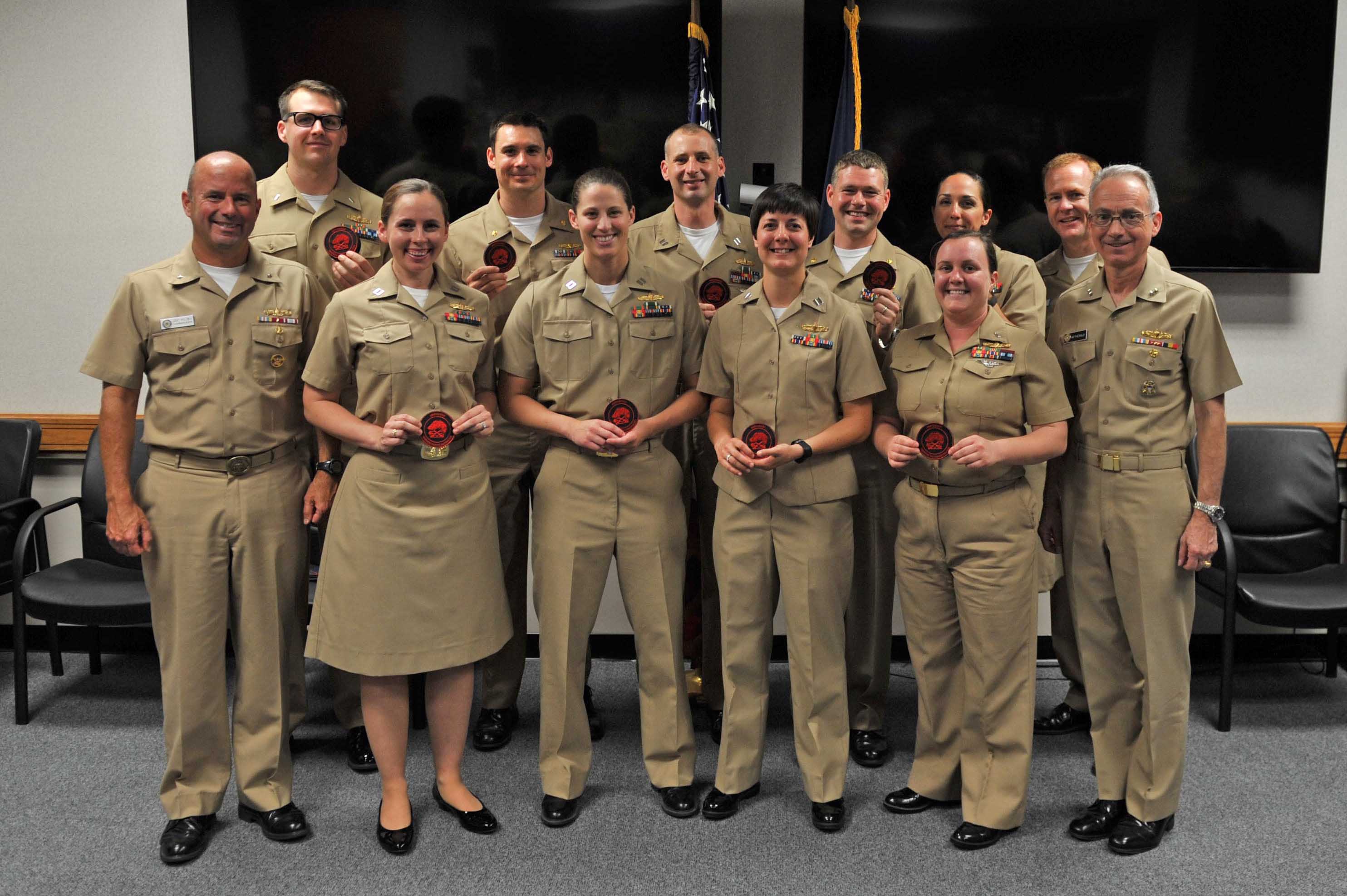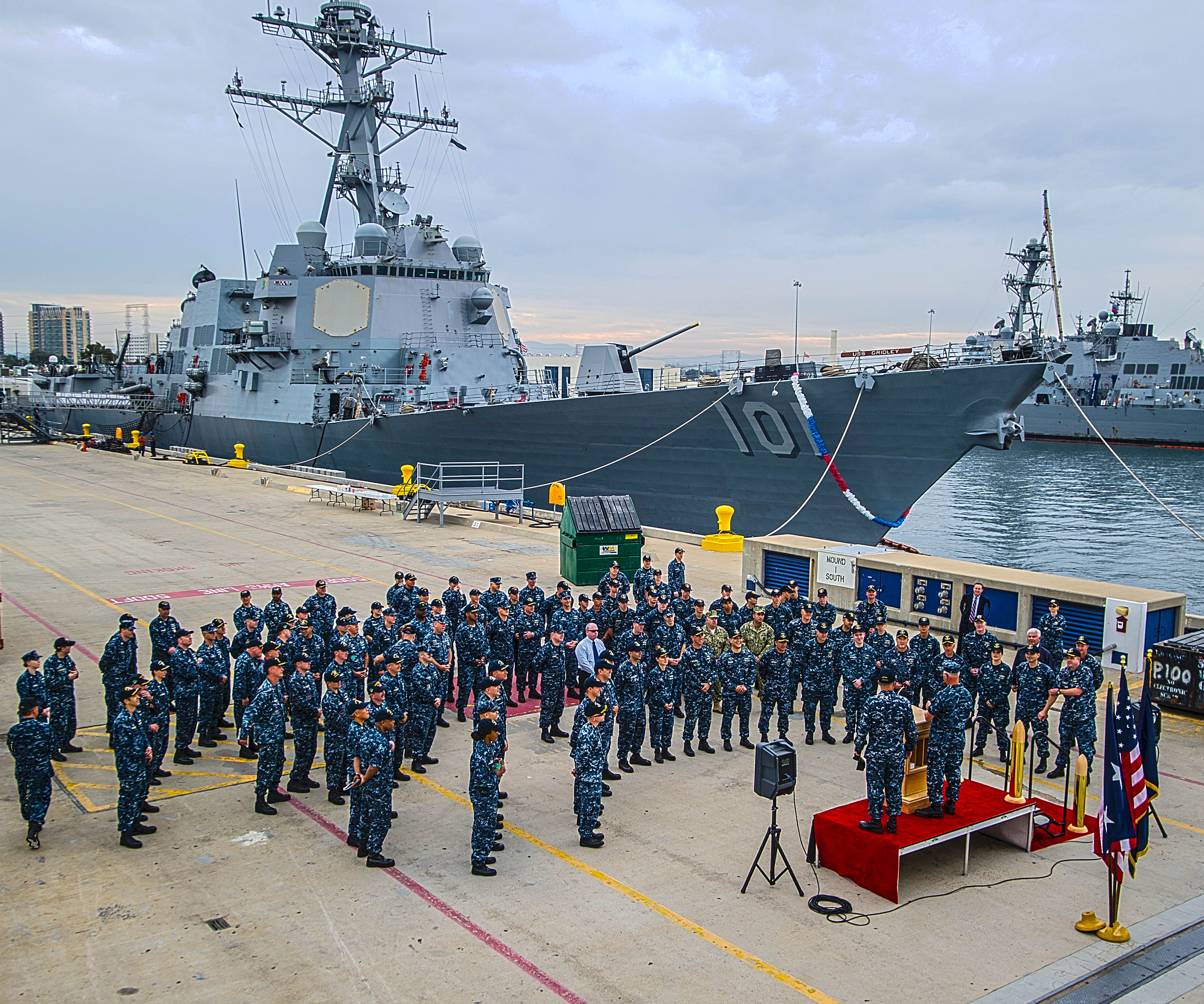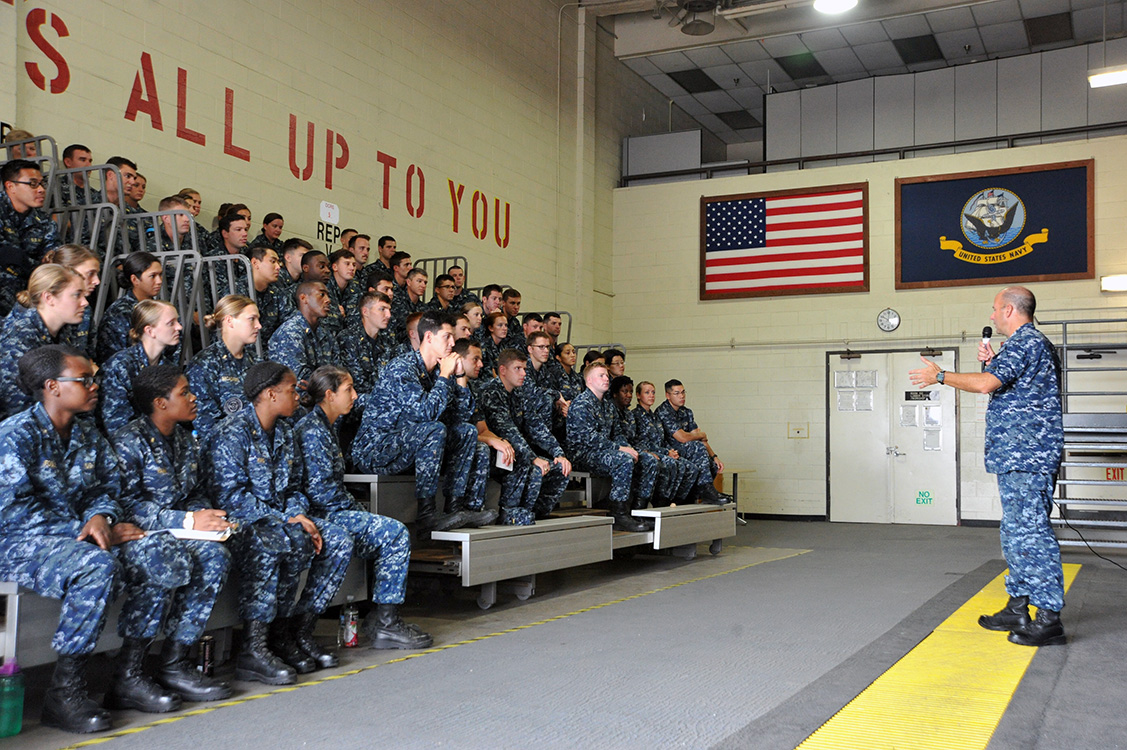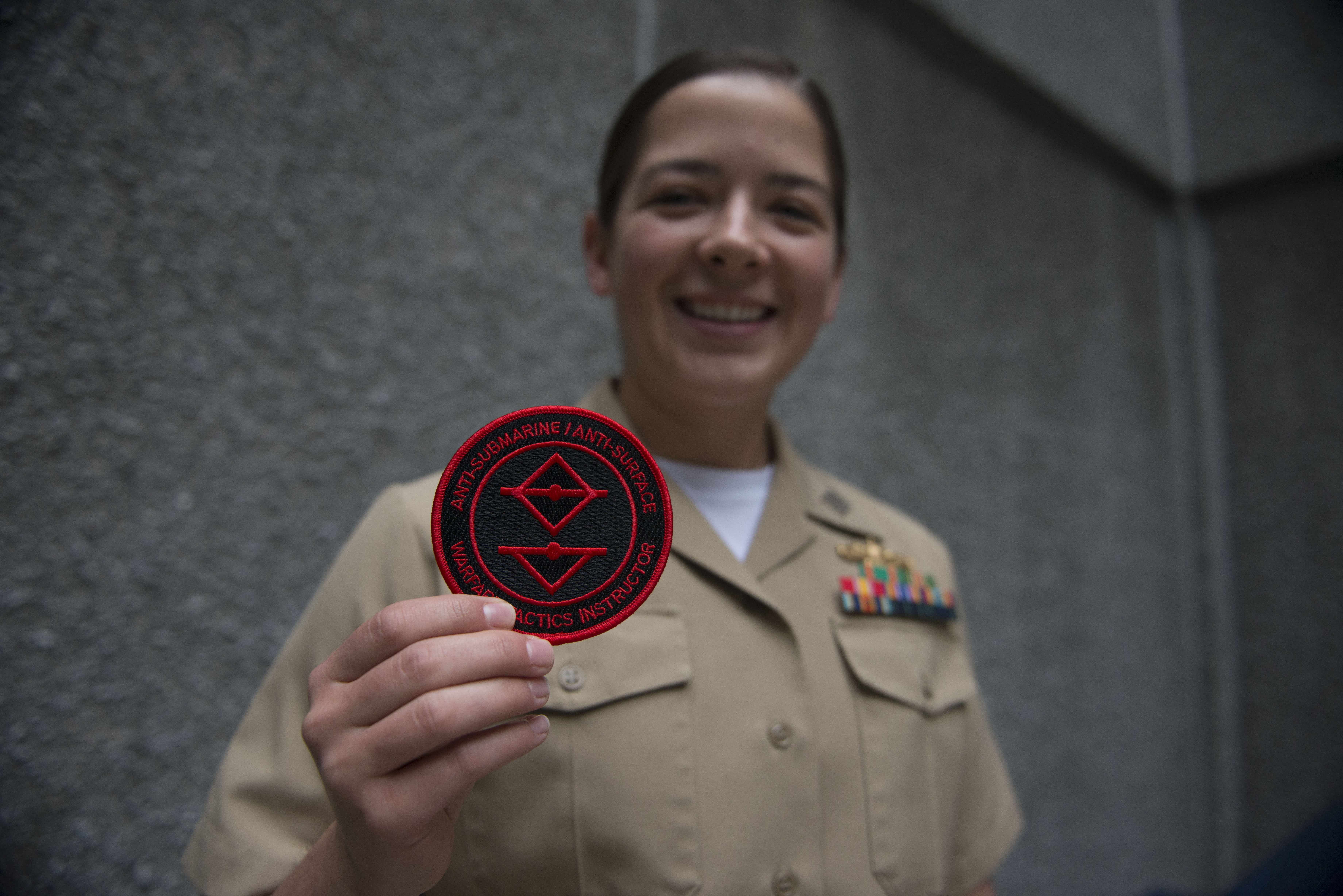
One year ago the Naval Surface and Mine Warfighting Development Center (SMWDC) stood up to develop Warfare Tactics Instructors – highly trained operators with a good tactical understanding of their warfare mission area, who could go out and teach the rest of the fleet. It was the surface community’s Top Gun, in essence.
Over the past year, SMWDC has worked on the WTI class curriculums for three different warfare areas – integrated air and missile defense (IAMD), amphibious warfare (AMW) and anti-submarine and surface warfare (ASW/SUW) – as well as developed and executed training events for ships preparing for deployment. Going forward, WTIs will begin writing doctrine and conducting major exercises.
SMWDC commander Rear Adm. Jim Kilby spoke to USNI News on June 3 to discuss the progress he and his team made over the last year and what challenges still lie ahead. The following is a transcript of the interview, edited for length and clarity.
USNI News: You have been at this for about a year now. I want to take the temperature of where you all are at now – how you feel about it, what are the things you are looking forward to doing moving ahead, and what are the things you are proud of. What challenges have you resolved or still need to resolve?
Kilby: I’ll start broadly. A bunch of us showed up here almost two years ago, and we officially stood up last year. I would say that I am very proud, encouraged, excited, and energized by our community and their adoption of and gravitation to what we are trying to achieve. At the lieutenant level, they love it. They want to and crave to have an avenue to pursue tactical things because they may not have gotten to that in their initial division officer tours. We have worked hard with our surface community to build a path that is understandable, articulable, and discernible as to how you would negotiate your career as a surface warfare officer with this experience as part of it. That’s been very gratifying.
Most recently, a month ago, we had a summit in Millington, Tenn., with all of the manning people talking about ways (to do that), the culture, how to pick them, how to advertise early, how to create a pool so they could align to billets they want to achieve. All of that is progressing faster than I thought it would. We have seven Integrated Air and Missile Defense (IAMD) Warfare Tactics Instructor (WTI) classes that have graduated. The last graduated at the end of May. The first amphibious warfare (AMW) WTI class graduated the day beforehand. Two months earlier, the first ASW/SUW WTI class graduated, and we are repeating that process with them. All of the machines are turning out product. The IAMD group is a little bit ahead just because they had a head start because of alignment. We are all showing lessons learned in aligning to each other to make sure we produce the same product regardless of disciplinary. That’s been my charter to everyone – I don’t care what your discipline is, we want to have graduates stand in front of folks and come off with the same level of competence and credibility and the ability to instruct across the board.
There’s a lot of sharing of information and alignment to make sure we do that. We are starting a pilot WTI course that we are calling a baseline course where all WTIs regardless of discipline will meet for two weeks and establish a community with each other and then go off to their separate disciplines to get their final training when they graduate. I would say for IAMD, we are pretty mature. I would say for ASW/SUW and amphibious WTI, we are probably 85 percent, and we are trying to figure out what is the other 15 percent. We might have to make some trades. We might have to do a little less of this to cover this topic which maybe we did not address fully enough. I want these curriculums to be dynamic as we move forward so we can address these abilities and threats as we move forward. It will not be a static process. It will be a curriculum that is under scrutiny and review all of the time to make sure it is current and as good as possible.

The WTI program is not up to capacity yet. We are producing the number of WTIs we project we need to in order to fill our billets. We are well on the way to do that. I am very happy with the enthusiasm and passion that I am seeing in those junior officers which is really what we want. We are trying to change the culture. We are trying to inject tactical thought and bias earlier in our young lieutenants so they can carry it with them throughout their entire career.
The next leg of it is doctrine and tactics. In the last year, we have gotten our arms around what we are responsible for. We are instituting a process to inject these WTIs in the creation and production of doctrine. Sometimes our doctrine can very dry and technical, describing the capability and too long to actually make it actionable. If you look at other communities, they pull out three sheets of paper with very specific guidance on how to execute that capability. We need to focus on telling our ships how to use and employ capability correctly and writing the doctrine from the perspective we would like to receive it as operators not technical writers.
The third leg that has made the most headway is called SWATT, Surface Warfare Advanced Tactical Training. That’s an event that we will inject as a community between the basic phase and the advanced phase, which is called the composite unit training exercise (COMPTUEX). We will take ships to sea and train them to be better prepared to go to that advanced training to get to the higher-end sight. In January, we had done two events. We are in the planning for three events at some level. The most mature will be the USS Nimitz (CVN-68) and will occur this fall when we execute 21 events. I was briefed on that yesterday in regards to where we are, what the schedule is, who is going to go out on what ship to execute these events. It is very exciting watching that happen.
All three of those elements are working about where I thought they would be. We do not have a long way to go. But I caution my staff not to get too excited about what we have achieved because we have much more to achieve. We should not ever be satisfied and say, hey, we’re good at that. We need to keep building and building and modifying as we gain understanding. Those three elements are key.
The other thing that I probably have not discussed with you to the level that I need to is the unique mission area, the mine warfare mission area, where I have a responsibility to deploy a battle staff to conduct exercises and operations for the U.S. Navy abroad and at home. Last week, I was at a mine warfare association symposium in Monterey, talking about the challenges of our capabilities now and the adversary and what I think we need to work on in the future.
I am spending a lot of time with Capt. Robert Baughman, who is the leader of the mine warfare division here in San Diego, preparing for that exercise with 138 participants from six countries that will start at the end of June and end on the second of August. That will prepare them for U.S. 3rd Fleet commander Vice Adm. Nora Tyson’s larger impact exercise that I am responsible for the mine warfare piece. That is exciting too, watching that develop and move forward. There are a lot of motivated folks over there looking forward to that exercise and the exercises we were assigned in U.S. 7th Fleet and U.S. 5th Fleet to go execute. We do stuff in U.S. 6th Fleet as well, so that staff is constantly on the move abroad and at home doing homeland defense requirements and requirements for mine warfare – which is unique from the other mission areas. I do not have an IAMD battle staff.
USNI News: Let’s talk about the embarked mine warfare battle staff. That’s an operational component instead of the training and doctrine piece that you have been working on. How does that mission fit into the rest of your work?
Kilby: We have chosen as a Navy to address these mining and mine countermeasure issues through this battle staff construct, which is what I am executing. That is the unique part. The mine warfare division is trying to figure out, how do we handle mine warfare and a warfare tactics instructor? Is that built into the construct of what we are doing?
We are working through that now. We have not made a final determination of that, but I suspect that it could find a place as an adjunct to the amphibious WTI expertise. Some number of the amphibious WTIs would likely go to a mine warfare supplemental school and will get that additional indicator on their shoulder so we can make assignments and keep track of them when they have that additional expertise. Some of the folks that come to the mine warfare detachment are not just surface warfare officers – they are ordnance disposal officers, they are aviators who have had experience in the aviation squadrons responsible for mine warfare. It is a mixed group of individuals with mine warfare experience and a centralized mode of expertise that can go forward and help plan and execute exercises and operations and make an input to the fleet commander for their operational plans on how to deal with mine warfare threats. It is a wealth of knowledge and expertise that now works under my rubric. Now, remember, when we first started talking, there was no M in this name. It was the Naval Surface and Warfighting Development Center. As we matured to stand up and get approval, the higher Navy leadership said, we want to make a separate distinction for mine warfare because of this battle staff construct that is unique in this role.
If you read deeply in the chief of naval operations’ Design for Maintaining Maritime Superiority, you will notice a huge emphasis on people and innovation and initiative to go bring these capabilities to their maximum potential. To me, that’s our WTI program. To me, that’s our SWATT program, creating a venue where we can better serve the surface community to fit into that training and continuing to deploy to be better prepared. My staff has a lot of interaction with foreign partners and industries. Today, the Dahlgren division was hosting the Norwegian Navy as they do twice a year for staff talks and understanding how we move forward together. I routinely go to South Korea and Japan and other nations to conduct mine warfare exercises and have mine warfare discussions. When the CNO talks about his maritime design, I think the WDC design fits very nicely into those constructs, specifically our close partner through an exercise with South Korea and how they prepare to live in the world they live in with their northern neighbors and how they position themselves to keep the Republic of Korea a forceful nation to do what their government wants them to do. We have a very close relationship with them. We do staff talk on mine warfare with them annually. Last year was the 32nd staff talk, and this year we will host them in August for the 33rd staff talk.

USNI News: Some people have referred to a surface warfare renaissance, or an opportunity for the Navy to think about surface warfare differently and potentially catching up after years of support for low-intensity ground conflict. You are right in the thick of it as far as distributed lethality and deploying surface action groups. We have heard about some new anti-surface weapons like SM-6, a modified Tomahawk, and some other variants of existing systems. That’s all of the stuff that we are hearing about right now, but you are on the leading edge. What should we be paying attention to? What are you excited about now and moving forward?
Kilby: Well, I think all of those things are still on our forefront. I am assigning folks from my staff to go shadow those efforts to make sure we are developing the tactical doctrine and guidance in stride with that capability as it moves forward. The one that I did not hear you mention Joint Strike Fighter. That’s very interesting because of the unique capabilities of that aircraft. We have WTIs following that effort as well.
I think we are looking to see that surface warfare officers understand those new tools in their toolbox and how to employ them, and that we set up training situations where they can practice that and do reps and sets and be confident in the use of that.
USNI News: Looking at the individual divisions for the WTI instruction, is there a personality or a culture that comes along with each one of them? You have integrated air and missile defense where you are talking about making decisions in fractions of a second. You have amphibious and mine warfare which is a different skill set. You are talking about ASW, antisubmarine warfare, that people call “awfully slow warfare.” The pace of these surface engagements is very different. Can you compare and contrast culturally what the big problems are and the solution sets for each one of those divisions that you mentioned?
Kilby: There are some inherent differences in the pace of that warfare area. We have been very purposeful in the way we approached it. You look at the WTI patches. They are all black with red lettering for a reason. I want them to not identify with their one warfare area but identify more so with the idea that they are a WTI for the surface community. They have a subset specialty, and the internals of the patch are based on what your discipline is. If you see it on the waterfront, you see a black patch with a red outline. You know that person is a surface warfare WTI. Then you have to get closer to figure out what is the disciplinary.

I am hoping through the maturation of these curriculums, we can have enough common hooks that we approach the tactical problem the same way to ensure we include all of the elements we need to – from the threat perspective on the technical capability and what we view adversaries as actually capable of doing based on observation, to how we set up that tactical solution set. While the time duration may be minutes and seconds from an IMD perspective, it may have to develop over hours as we develop the ASW solution set. I still want to have the same level of detail and emphasis and understanding in tactical doctrine to employ to the best level. No one is better than the other. That is why your patches all look the same from a color perspective, but you bring different capabilities to us based on your disciplinary.
I still maintain that the amphibious WTI program is the most complex. It covers the broadest area. They have got to do ship-to-shore movement. They have got to plan and integrate with the Marines, another service, a naval service group. The Marine Corps is different than the Navy, so they’ve got to make that team as strong as possible. We have new capabilities like Joint Strike Fighter and SSDS Mods 1-6 , which is the latest combat system on those ships, very capable to bear. They have got a pretty broad view of the world. Giving them a curriculum that allows them to go be effective across all of those three things is a challenge.
I am excited with what we have achieved. I do not miss all of the enormity of the task ahead.
Even with all that progress, we are in the early days here, and we just need to continue to stay the course and move forward and continue to make headway. I think it is worthwhile for us to acknowledge that the aviation Top Gun program started in 1969. 1969, that’s a long time ago. They are in their fourth decade here and are continuing to evolve and mature the process, as I think we will as well. We have to make a commitment to stay the course, and my command is here to do that.





